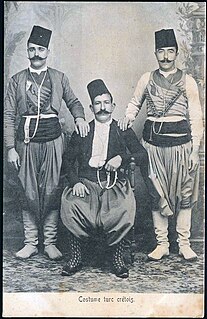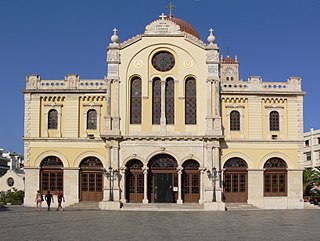
The Aegean Sea is an elongated embayment of the Mediterranean Sea located between the Greek and Anatolian peninsulas i.e. between the mainlands of Greece and Turkey. In the north, the Aegean is connected to the Marmara Sea and Black Sea by the Dardanelles and Bosphorus. The Aegean Islands are within the sea and some bound it on its southern periphery, including Crete and Rhodes.

Heraklion or Heraclion is the largest city and the administrative capital of the island of Crete and capital of Heraklion regional unit. It is the fourth largest city in Greece. According to the results of the 2011 census, the municipality's population was 173,993 and according to the results of 2011 census, the metropolitan area has a population of 225,574 and it extends over an area of 684.3 km2 (264.2 sq mi).

The Battle of Crete was fought during the Second World War on the Greek island of Crete. It began on the morning of 20 May 1941, when Nazi Germany began an airborne invasion of Crete. Greek and other Allied forces, along with Cretan civilians, defended the island. After one day of fighting, the Germans had suffered heavy casualties and the Allied troops were confident that they would defeat the invasion. The next day, through communication failures, Allied tactical hesitation and German offensive operations, Maleme Airfield in western Crete fell, enabling the Germans to land reinforcements and overwhelm the defensive positions on the north of the island. Allied forces withdrew to the south coast. More than half were evacuated by the British Royal Navy and the remainder surrendered or joined the Cretan resistance. The defence of Crete evolved into a costly naval engagement; by the end of the campaign the Royal Navy's eastern Mediterranean strength had been reduced to only two battleships and three cruisers.

The history of Crete goes back to the 7th millennium BC, preceding the ancient Minoan civilization by more than four millennia. The Minoan civilization was the first civilization in Europe and the first, in Europe, to build a palace.

Konstantinos Mitsotakis was a Greek politician who was Prime Minister of Greece from 1990 to 1993. He graduated in law and economics from the University of Athens.

The Greco-Turkish War of 1897, also called the Thirty Days' War and known in Greece as the Black '97 or the Unfortunate War, was a war fought between the Kingdom of Greece and the Ottoman Empire. Its immediate cause was the question over the status of the Ottoman province of Crete, whose Greek majority long desired union with Greece. Despite the Ottoman victory on the field, an autonomous Cretan State under Ottoman suzerainty was established the following year, with Prince George of Greece and Denmark as its first High Commissioner.

The Cretan Turks, Muslim-Cretans or Cretan Muslims were the Muslim inhabitants of the Greek island of Crete and now their descendants, who settled principally in Turkey, the Dodecanese Islands under Italian administration, Syria, Lebanon, Israel, Libya, and Egypt, as well as in the larger Turkish diaspora.

The Cretan State, was established in 1898, following the intervention by the Great Powers on the island of Crete. In 1897, an insurrection in Crete headed by the Ottoman Empire to declare war on Greece, which led Great Britain, France, Italy and Russia to intervene on the grounds that the Ottoman Empire could no longer maintain control. It was the prelude to the island's final annexation to the Kingdom of Greece, which occurred de facto in 1908 and de jure in 1913.
Eleftherios Venizelos Foundation is a national research foundation in Chania, Crete, founded on the 26th of March 2000. It is a center for research and study of the work and the era of Eleftherios Venizelos. Its activities include organizing events, conferences, education, research, awards, grants, exhibitions, collaborations and publications. The Foundation premises are located in the residence of Eleftherios Venizelos in Halepa square, Chania.

Greece is a country in Southern Europe, bordered to the north by Albania, North Macedonia and Bulgaria; to the east by Turkey, and is surrounded to the east by the Aegean Sea, to the south by the Cretan and the Libyan Seas, and to the west by the Ionian Sea which separates Greece from Italy.

Gramvousa also Grampousa refers to two small uninhabited islands off the coast of a peninsula also known Gramvousa Peninsula in north-western Crete in the regional unit of Chania. The Gramvousa Peninsula forms the westernmost of the two pairs of peninsulae in north-western Crete and is the western part of Kissamos Bay.

The island of Crete was declared an Ottoman province (eyalet) in 1646, after the Ottomans managed to conquer the western part of the island as part of the Cretan War, but the Venetians maintained their hold on the capital Candia until 1669, when Francesco Morosini surrendered the keys of the town. The offshore island fortresses of Souda, Granbousa, and Spinalonga would remain under Venetian rule until in 1715, when they too were captured by the Ottomans.

The Church of Crete is an Eastern Orthodox Church, comprising the island of Crete in Greece. The Church of Crete is semi-autonomous (self-governing) under the jurisdiction of the Ecumenical Patriarchate of Constantinople. The current Archbishop of Crete is, since 30 August 2006, Irinaios Athanasiadis.

Michail Korakas was a Cretan revolutionary, who played a major role in successive Cretan revolts against the Ottoman Empire in 1821–29, 1841, 1858, 1866–69, and 1878.
Emmanouil Antoniadis (1791–1863) was a revolutionary in the Greek War of Independence, a politician and a journalist from the island of Crete.
The Cretan revolt of 1878 was an insurrection of the Cretan people against the Ottoman occupation of the island. This insurrection is part of a larger movement for independence from the Ottoman Empire, which Crete was part of since the middle of the 17th century.
The Candia massacre occurred on September 6, 1898, on the island of Crete, then part of the Ottoman Empire. It occurred as a reaction by armed Muslim irregular groups to the offer to the Christian community of a series of civil rights. They attacked the British security force in Candia, which was part of an international security force on the island. Muslim irregulars then proceeded to massacre the local Christians in the city. As a result 14 British military personnel were killed, the British vice-consul and his family were burnt alive in their house and 500–800 Christian inhabitants are estimated to have been massacred. A significant part of Candia was burnt and the massacre ended only after British warships began a blanket bombardment of the city. The incident accelerated the end of Ottoman rule on Crete and two months later the last Ottoman soldier left the island.
















